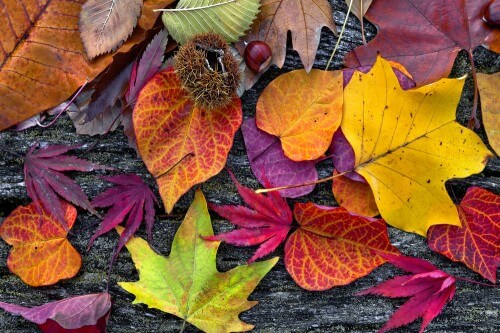New research shows that the color of leaves when they fall can indicate the condition of the soil, and that this natural marker can be used to help trees

In autumn the forests change their colors. We have few forests, so the phenomenon of dumping is not common, but in many countries dumping is an inspiration for artists and a beautiful and interesting sight for residents and tourists. Why do the leaves change their colors? What is the benefit to trees?
The green color of the leaves is given to them by the chlorophyll, the chlorophyll enables assimilation, that is, the conversion of carbon dioxide into sugars that serve as nutrients for the plant, in winter low temperatures that do not allow the leaves to exist, as well as a little sunlight that is not enough for assimilation.
To avoid wasting energy, the tree discards its leaves, but the leaves contain nutrients that should not be wasted, so before discarding the tree "sucks" the nutrients, in the first step the leaves lose their green chlorophyll and turn yellow to red. Since the leaves stop using the sunlight for assimilation there is a possibility of damage by radiation, the assumption is that the red color dyed by anthocyanin and the yellow obtained from the presence of carotenoids protect the branches from ultraviolet radiation and are antioxidants, antioxidants. So far the things are known, accepted and already written.
We would add that unlike the carotenoids that exist in leaves and their color is revealed due to the disappearance of chlorophyll, anthocyanin is produced and "flowed" to the leaves by the plant in preparation for shedding. The question arises why does the tree "waste" energy to produce anthocyanin?
There are assumptions (which are not proven) that the red color increases the temperature of the environment and perhaps attracts birds that will eat the last of the fruits and spread seeds. There are observations where redder leaves were seen when autumn was particularly cold, now it turns out that the color of the leaves is related to the quality of the soil. The lower the quality of the soil, the more effort the tree will make to "pump" nutrients from it. Therefore, the poorer the quality of the soil, the redder the leaves will be. Most nutrients are absorbed into the different parts of the plant. To prevent harmful radiation and perhaps also to raise the local temperature and attract foreign birds, the plant added the red pigment to the leaves...?
At the same time, there is an increase in yellow color as the quality of the soil increases, soil is richer in food and therefore the plant does not need to invest energy in "pumping" food from the leaves.
In a study done by Emily Habinck (Emily Habinck from the University of North Carolina, Charlotte). It turned out that trees that grew on mountain slopes are redder than trees (of the same species) that grow on the plains. It will be explained that the soil in the plains is richer in nutrients than the soil on the slopes.
The species of trees tested are two species of maple, both species are a source of "maple syrup" and hence the local importance of the research. By taking a picture of the situation in the fall, you can tell from which trees you can get more of the "sweet sweet". In a wider range, it is possible to locate areas where the trees are suffering, by a simple observation of the colors of the fall. And again, the research shows how the tree behaves, but does not explain/clarify why the tree should be colored red.
The article was first published on the site on November 16, 2007
On the same topic on the science website
* Why on the autumnal equinox day and night are not exactly equal?
* Exploring the sun through ancient civilizations

7 תגובות
MouthHole
I don't think the tree is trying to enrich the soil. The poorer the soil, the harder the tree tries to extract nutrients from the leaves before discarding them. Of course, "trying" and "making an effort" are personifications, and do not describe what really happened.
According to my understanding, the meaning is that the poorer the quality of the soil, the tree in the autumn period will put in much more effort and will therefore be able to extract more nutrients than a tree whose soil is already rich. Thus he enriches the soil for the next period. That's why the leaves are red.
I have no prior knowledge, only from reading the article.
The contradiction was not clear to me either
That's why I marked the end of the paragraph
with the question mark (?),
For the notebook (Emily) the solutions.
To the curious - exactly what I thought and didn't understand either.
I would appreciate an answer from the author of the article or another scholar 🙂
I got confused - something was said here and the opposite - if the soil is poor, and the plant wants to flow nutrients from it to the rest of the tree - then the leaves are supposed to be yellow - so no substance is flowed into the leaves... because the soiling of the leaves involves investing energy and materials into the leaves, unless the chroinitides have a greater value from the anthocyanins and transferring them into the leaf……and the plant prefers to make these "exchanges"...but it's not specified....in any case-it's fascinating!